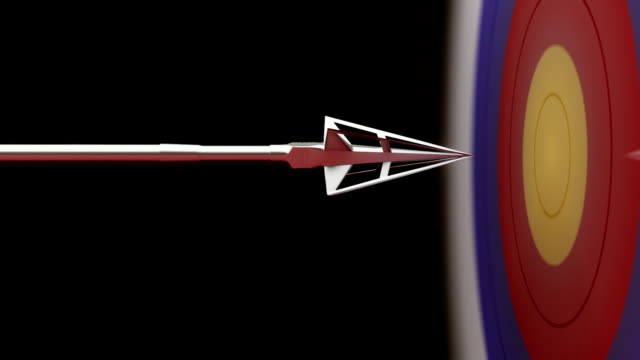The science behind archery: understanding how arrows fly and hit their targets is a fascinating subject. Archery has been practiced for centuries, and it all revolves around the physics of arrow flight.
By harnessing the forces of gravity, air resistance, and bow mechanics, archers are able to propel arrows with precision and accuracy.
We will explore the key factors that determine an arrow’s trajectory, including arrow weight, draw weight, arrow spine, and distance.
Delving into the principles of aerodynamics and ballistics, we will uncover the secrets behind the art of archery and how archers are able to consistently hit their targets.
So, let’s dive into the intricate world of archery and unravel the science behind this ancient sport.

Credit: www.shutterstock.com
The Role Of Aerodynamics In Archery
Archery relies on aerodynamics to understand how arrows fly and accurately hit their targets.
The role of air resistance is crucial in determining the trajectory of an arrow. It influences its speed, stability, and overall flight.
Arrow fletchings play a significant role in flight stability by managing the interaction between the arrow and the air.
These small, feathered vanes help stabilize the arrow by reducing spin and adjusting its trajectory. Another fascinating aspect is the magnus effect, which affects the arrow’s path due to the rotation imparted by the archer.
The magnus effect causes the arrow to curve in the direction opposite to its spin, allowing for more precision in hitting the target.
Understanding these principles is essential for archers to consistently achieve accurate shots. The science behind archery is a fascinating blend of physics and skill – a perfect demonstration of how human precision can overcome the challenges posed by nature.
The Influence Of Bow Mechanics On Arrow Trajectory
The smooth flight and precise targeting of arrows in archery is governed by a complex interplay of mechanics. One crucial factor is the influence of the bow itself on arrow trajectory.
The power and velocity of the bowstring play a significant role in determining how far and how accurately an arrow can travel.
The draw weight, or the force required to draw the bowstring back, directly affects the arrow’s flight. The higher the draw weight, the more energy is transferred to the arrow, resulting in greater speed and distance.
Another aspect to consider is the bow’s limbs, which flex as the string is released, propelling the arrow forward.
The design and construction of these limbs impact the bow’s accuracy, with stiffer limbs offering better control for hitting targets.
Understanding these factors helps archers optimize their shooting technique and achieve greater precision in hitting their intended mark.
Grasping The Factors Affecting Arrow Accuracy
To achieve accuracy in archery, mastering proper form and stance is crucial. Understanding how release technique impacts arrow path and trajectory is equally important.
Additionally, the significance of arrow spine cannot be overlooked. By grasping these factors, archers can enhance their skills and hit their targets with precision.
By maintaining the right posture and grip on the bow, archers ensure consistent shots. The release technique influences the flight of the arrow, as any deviation can alter accuracy.
Moreover, the arrow spine plays a significant role in arrow flight and impact.
It determines how the arrow flexes during release, affecting its stability and accuracy. By comprehending these factors, archers can fine-tune their technique, improve their aim, and achieve impressive results on the archery range.
Real-Life Applications Of Archery Science
Archery is not just a sport, but a fascinating application of science. Understanding how arrows fly and hit their targets is essential for achieving accuracy and precision.
In sports like archery, shot placement is meticulously analyzed to improve the shooter’s performance.
The art of creating suspenseful shots in films and television is another real-life application of archery science.
From aiming techniques to the design of bows and arrows, the science behind archery is ever-evolving. Its impact can be seen in various fields, making it an interesting subject for exploration and study.
Whether on the sports field, in the wilderness, or on the silver screen, the principles of archery inspire awe and fascination.
Advancements In Bow Designs For Maximum Accuracy
Archery has a fascinating science behind it, involving the flight and precision of arrows. With advancements in bow designs, maximum accuracy is now more attainable.
Compound bows have unveiled innovative features that enhance precision. These bows combine tradition with technological enhancements, offering a superb shooting experience.
Recurve bows are not left behind, as they too have benefitted from technological advancements. Their synergy of tradition and innovation brings unparalleled accuracy to archers.
Another rising trend is the popularity of hybrid bows. These bows merge the best qualities of different bow types, delivering exceptional performance.
The combination of traditional elements with modern technology has taken archery to new heights.
Whether you prefer a compound, recurve, or hybrid bow, the science and innovations behind archery ensure arrows hit their targets with impressive accuracy.
Cutting-Edge Arrow Technologies And Materials
Archery is a fascinating sport that involves precision and skill. Understanding how arrows fly and hit their targets requires knowledge of cutting-edge arrow technologies and materials.
One such material is carbon fiber, which offers a lightweight and durable option for arrows, resulting in high-performing shots.
On the other hand, aluminum arrows provide balance and consistency during flight, ensuring accurate and predictable outcomes.
As we delve into the digital age, there is potential to explore smart arrows, which could revolutionize the sport. These arrows may incorporate technology that enhances accuracy, adjusts trajectory, or even provides real-time feedback to archers.
The science behind archery and the advancements in arrow technologies are intriguing and continue to push the boundaries of the sport.
With ongoing research and innovation, the future looks promising for archers seeking to improve their performance and hit their targets with precision.
The Role Of Data Analysis In Modern Archery
Data analysis plays a crucial role in modern archery, optimizing shot placement with ballistics software. Sensors and biomechanics aid in training, while video analysis enhances performance improvement.
By analyzing various data points, archers can refine their technique and accuracy, aiming for precision and consistency.
The trajectory of an arrow is influenced by multiple factors, including the release, bow speed, and environmental conditions.
With the help of advanced technology, archers can identify areas for improvement, adjust their form, and refine their shooting strategy.
By leveraging data-driven insights, archers can enhance their skills, increase their accuracy, and consistently hit their targets.
The science behind archery provides a deeper understanding of how arrows fly, empowering archers to become more effective and skilled in their pursuit of hitting the bullseye.
Frequently Asked Questions On How Arrows Fly And Hit Their Targets
How Do Archers Aim Their Arrows With Precision?
Archers aim their arrows by aligning their dominant eye with the target and using the bow’s sight to focus.
What Factors Affect The Trajectory Of An Arrow?
The trajectory of an arrow is influenced by factors such as distance, wind speed, arrow weight, bow draw weight, and archer’s technique.
What Is The Science Behind Arrow Flight Stability?
Arrow flight stability is achieved through the combination of factors like fletching, arrow spine, and center of mass, ensuring a straight and accurate flight path.
Conclusion
Understanding the science behind archery is crucial for mastering the art of hitting targets with precision. From the moment the arrow is released from the bowstring, a series of intricate processes determine its flight path and ultimate destination.
Factors such as arrow speed, weight, and design all interact with the archer’s technique and the forces of physics to influence the arrow’s trajectory.
The archer’s focus, breathing, and stability, along with the bow’s power and arrow release, all affect the flight of the arrow.
By delving into the principles of aerodynamics, newton’s laws of motion, and the physics of energy transfer, archers can gain a deeper appreciation for the skill and precision required to hit their targets consistently.
So, whether you are a professional archer or a beginner, understanding the scientific principles behind archery can enhance your accuracy and elevate your performance.

General Manager & Auditorial Head.
Killian Jake is a World Sports Traveler and hobbyist sports lover. By exploring different sorts of playing modules like indoor, outdoor, and many more. As for professionalism and writing, it’s helpful to give you the right suggestions on different games and sports.





